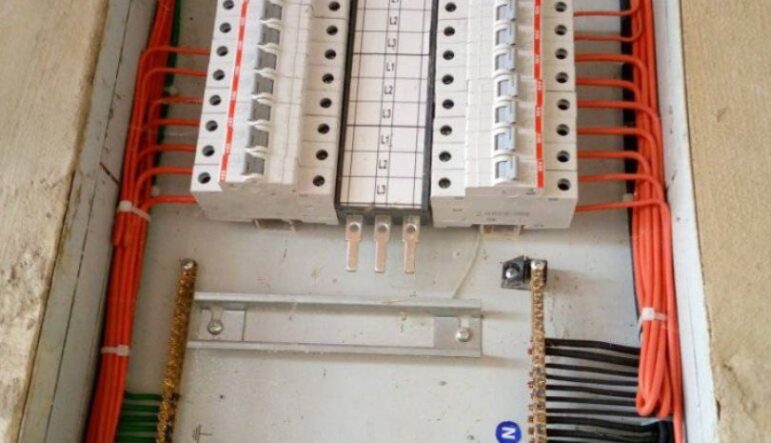Home / Core-Power Blog Posts / Uncategorized / Distribution Board Maintenance: Tips to Ensure span and Efficiency
Distribution boards, also known as electrical panels or breaker boxes, play a crucial role in distributing electricity safely and efficiently throughout a building. To ensure the longevity and efficiency of your distribution board, proper maintenance is essential. In this article, we will discuss some valuable tips that can help you maintain your distribution board effectively.
Distribution boards act as the central hub for electricity distribution within a building. They receive electrical power from the main supply and distribute it to various circuits, ensuring that electrical appliances and equipment receive the appropriate voltage and current. Proper maintenance of the distribution board is vital to prevent electrical failures, malfunctions, and potential hazards.
Regular maintenance of the distribution board offers several benefits. It helps identify any potential issues before they escalate into major problems, ensures electrical safety, and prolongs the lifespan of the distribution board. By following a few maintenance practices, you can significantly enhance the longevity and efficiency of your distribution board.
Performing regular visual inspections is the first step in distribution board maintenance. Check for any visible signs of damage, loose connections, or overheating. Look out for melted insulation, burned marks, or corrosion. If you notice any abnormalities, it’s crucial to address them promptly.
Over time, the connections within the distribution board can become loose due to vibrations or thermal expansion and contraction. Loose connections can lead to arcing, overheating, and electrical fires. Regularly tighten the terminal screws and busbar connections to ensure a secure and reliable electrical connection.
Dust accumulation can hinder the proper functioning of the distribution board. Dust acts as an insulator, leading to heat buildup and reduced efficiency. Regularly clean the distribution board using a soft brush or a vacuum cleaner to remove any dust or debris. Ensure that the power supply is turned off before cleaning.
Circuit breakers are crucial components of a distribution board that protect against overcurrent and short circuits. Periodically test the circuit breakers to ensure they trip correctly and provide adequate protection. Follow the manufacturer’s guidelines for testing procedures and consult a professional if you encounter any issues.
If you identify any faulty components during your maintenance inspection, it is important to replace them promptly. Faulty circuit breakers, damaged cables, or worn-out terminals can compromise the performance and safety of the distribution board. Always use genuine replacement parts and consult a qualified electrician if necessary.
Proper ventilation is essential to dissipate heat generated by the distribution board. Ensure that the distribution board is not obstructed by objects or covered with materials that restrict airflow. A well-ventilated distribution board operates more efficiently and reduces the risk of overheating.
Moisture can corrode electrical connections and components, leading to poor performance and potential electrical hazards. Take measures to protect the distribution board from moisture, especially in areas prone to high humidity or water exposure. Use moisture-resistant materials, seal any gaps or openings, and consider installing a dehumidifier if necessary.
Apart from visual inspections, regular testing of the distribution board is crucial to ensure its proper functioning. Test the voltage, current, and insulation resistance periodically using appropriate testing equipment. This helps identify any underlying issues and allows for timely maintenance or repairs.
While basic maintenance can be performed by building owners or facility managers, it’s recommended to involve a qualified electrician for professional maintenance at regular intervals. Electricians have the expertise to perform in-depth inspections, identify hidden issues, and ensure compliance with safety standards.
If your building has an outdated or inadequate distribution board, considering an upgrade can enhance its efficiency and safety. An upgraded distribution board with modern components and features can accommodate increased electrical loads, incorporate advanced protective devices, and improve overall energy management.
Understanding common issues that may arise with distribution boards can help you identify and address problems promptly. Some common issues include circuit overloading, short circuits, faulty wiring, loose connections, and inadequate protection. Stay vigilant and seek professional assistance if you encounter any of these issues.
Proper maintenance of the distribution board is essential for ensuring its longevity and efficiency. Regular visual inspections, tightening connections, cleaning, verifying circuit breaker operations, replacing faulty components, ensuring adequate ventilation, protecting against moisture, regular testing, professional maintenance, and considering upgrades are vital practices for maintaining a reliable and safe distribution board.
Incorporating these maintenance tips will not only extend the lifespan of your distribution board but also minimize the risk of electrical hazards, interruptions, and costly repairs. Remember to prioritize safety, consult professionals when needed, and adhere to electrical codes and regulations.
1. How often should I perform maintenance on my distribution board?
Perform visual inspections monthly and conduct more in-depth maintenance annually or as recommended by a qualified electrician.
2. Can I clean the distribution board while it’s powered on?
No, always turn off the power supply before cleaning or performing any maintenance tasks on the distribution board.
3. What are the signs of a faulty distribution board?
Signs of a faulty distribution board include tripping breakers, flickering lights, burning smells, or visual damage such as melted insulation or corrosion.
4. How long does a distribution board typically last?
With proper maintenance and regular inspections, a distribution board can last 20 to 30 years or more. However, older boards may require upgrades for improved safety and efficiency.
5. Can I upgrade my distribution board myself?
It’s recommended to consult a qualified electrician for distribution board upgrades to ensure proper installation, compliance with regulations, and optimal performance.
Contact CORE-POWER now for your distribution board upgrade.
Hello, welcome to Core-Power Ltd🤓
What can we do for you today?
🟢 Online
Let's Chat


Very helpful